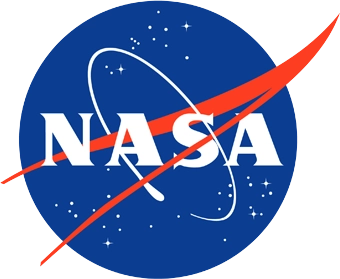
What is your research focus?
My research focuses on understanding the chemical and physical processes that alter planetary and interstellar ices. I use laboratory techniques like infrared and ultraviolet-visible spectroscopy, and mass spectrometry to characterize these ices and how they respond when exposed to radiation or changes in temperature. I can use these data to address questions about the origin and distributions of complex organic molecules in astronomical environments, and the habitability of extraterrestrial environments.
I have conducted studies ranging in topic from the low-temperature (-333 ℉) chemistry of sulfur compounds that are expected to be on the surface of Europa to the spectral fingerprint of porous water on interstellar dust grains. Currently, I am trying to measure how quickly nitrogen-containing compounds that are important to life on Earth, like pyridine and pyrimidine, are destroyed when exposed to high energy radiation and how that might explain the observed absence of these compounds in interstellar space.
Did you always know that you wanted to be a laboratory astrochemist?
Nope, I did not! In high school I attended culinary arts classes and competed in state-level cooking competitions in Phoenix and Tucson. Since I graduated high school, I worked in several professional kitchens, and I thought that I would be a chef.
But, as an undergraduate student, I received my first opportunity to conduct research: quantifying the arsenic content of iron and copper samples using lasers. Still not quite astrochemistry, but I learned that I enjoyed hands-on laboratory work. I find it incredibly satisfying to design, build and implement a tangible thing that I can use to address an interesting science question. I also had the opportunity to participate in the Arkansas Balloon Satellite program and the NASA-sponsored Nationwide Eclipse Ballooning Project as an undergraduate. My experience with this project and viewing my first total solar eclipse in totality was surreal. It sparked my interest in astronomy and NASA. I applied to graduate school hoping to combine my love of experimental work and interest in astronomy, and I was fortunate that my Ph.D. advisor gave me the opportunity to explore how laboratory work can be applied to understand environments as extreme as those in astronomy and planetary science.
Right: With my cat Emily (begrudgingly) celebrating graduation. She’s read more manuscript drafts and listened to more presentations than she could ever count.
What research accomplishment are you most proud of?
I am particularly proud of my work on the P. R. Behr et al. 2020 article published in the Astrophysical Journal. In this paper, we demonstrate that energetic electrons can compact porous water ice using ultraviolet-visible spectroscopy, and we refine the estimated compaction time of water ice within interstellar cold dense molecular clouds. This estimate helps constrain the chemical history of interstellar water ice since its morphology might impact how well volatile gases are trapped in the ice. To make these calculations, we needed to independently determine the thickness of our ice samples. To do that, I coupled a specular reflectance model to a spectral fitting technique that I learned during my first graduate course at Northern Arizona University (NAU): a special topics course covering exoplanets. I applied the combined model to laboratory spectra acquired by a then REU student to determine the thickness of all our ice samples. I am proud that I was able to take this statistical method and apply it to a research problem outside of its intended field, and that I could develop a tool that other students in the laboratory at NAU have successfully used and improved upon since. I think that this work highlights the importance of cross-disciplinary collaboration and project-based classwork.
I find it incredibly satisfying to design, build and implement a tangible thing that I can use to address an interesting science question.
What does a typical day at work look like for you?
One of my favorite things about my job is that I don’t have typical days. Sometimes my days are spent designing and conducting publishable laboratory experiments. Other days are spent troubleshooting or updating laboratory equipment. Some of my days are spent writing code to analyze data or learning basic machining and plumbing. This variety keeps me excited about my work and every day presents a new challenge to overcome.
What early career advice do you have for those looking to do what you do?
My advice for those people would be to get involved in laboratory research as early as they can! Email their favorite professor and ask them about their active research projects. Try to get as much experience as early as possible. I would also remind all early career scientists to maintain a healthy support system. I would not have made it to where I am today without my family, friends, and mentors.
What are your future research interests and goals?
My future research goals are to continue to learn new techniques and skills that I can use to characterize astrophysical material analogs. I would like to continue to branch out into different kinds of solid materials like salts and organic residues. Understanding the chemical and physical properties of salts, especially chlorides and sulfates, will become more important as NASA’s Europa Clipper mission begins exploring the surface of Europa, which is expected to be covered in salts. Organic residues produced from irradiated and warmed ices are interesting since they can be used to simulate a variety of different extraterrestrial icy environments. These residues have been used to explain the surface properties of asteroids and many outer solar system objects. They are also often composed of molecules important to astrobiology and can be studied to improve our understanding of prebiotic chemistry. The astronomy and planetary science community has made so many awesome discoveries over the last decade, advancing science. I am excited to use my skills and techniques to contribute to this progress!
What do you like to do in your free time?
I enjoy brewing beer! I’ve been brewing since 2017, and I think that it’s a fun way to mix my interests of science and cooking. I also enjoy traveling, mountain biking, rock climbing, wood carving, and spending time with my fiancée, Caitlan, and our three cats (Emily, Mirin, and Kiko).
Published Date: Sep 30, 2025.
Hometown:
Kingman, Arizona
Undergraduate Degree:
B.S. Physics, Arkansas State University, Jonesboro, Arkansas
Post-graduate Degrees:
M.S. Astronomy and Planetary Science, Northern Arizona University, Flagstaff, ArizonaPh.D. Astronomy and Planetary Science, Northern Arizona University, Flagstaff, Arizona
